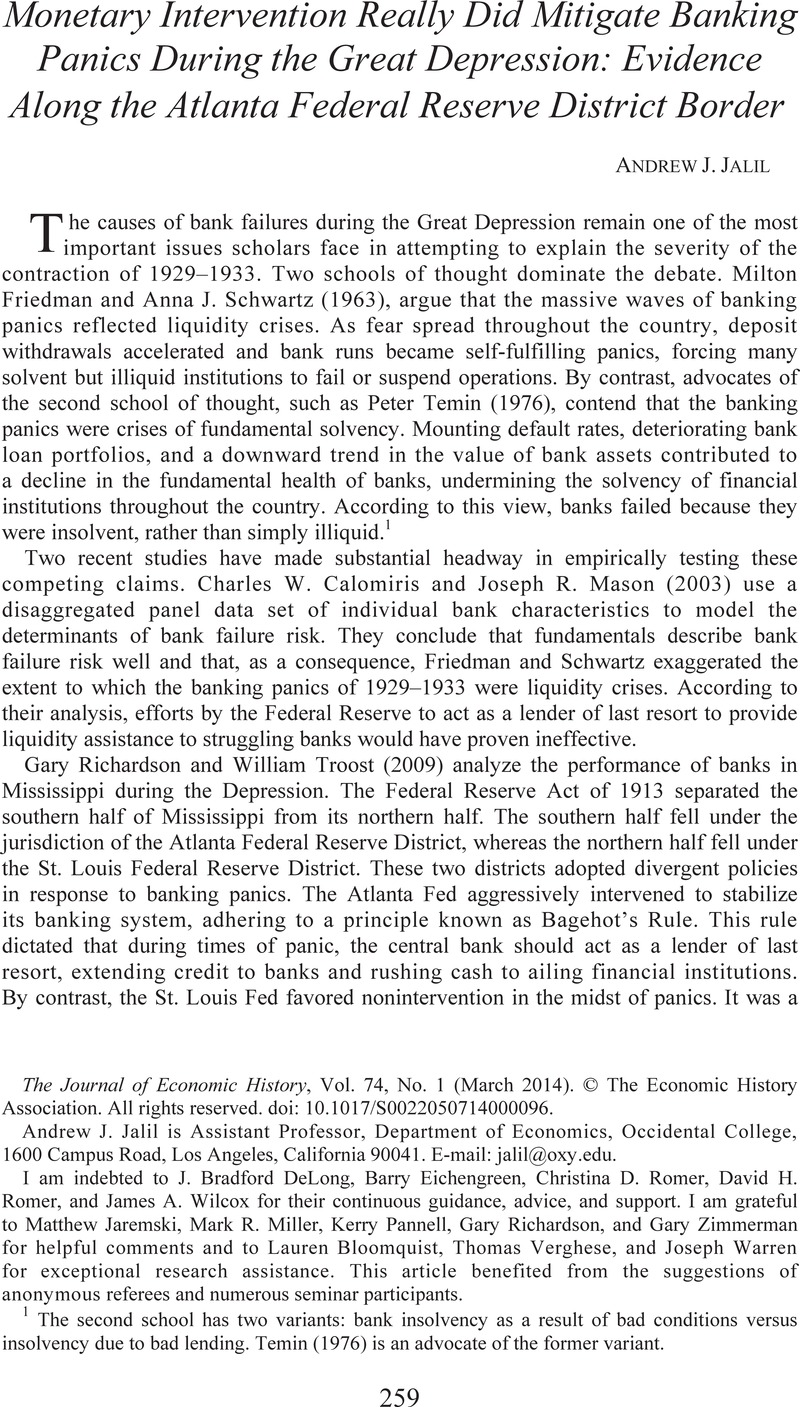Article contents
Monetary Intervention Really Did Mitigate Banking Panics During the Great Depression: Evidence Along the Atlanta Federal Reserve District Border
Published online by Cambridge University Press: 24 February 2014
Abstract
An abstract is not available for this content so a preview has been provided. Please use the Get access link above for information on how to access this content.

- Type
- Note
- Information
- Copyright
- Copyright © The Economic History Association 2014
Footnotes
I am indebted to J. Bradford DeLong, Barry Eichengreen, Christina D. Romer, David H. Romer, and James A. Wilcox for their continuous guidance, advice, and support. I am grateful to Matthew Jaremski, Mark R. Miller, Kerry Pannell, Gary Richardson, and Gary Zimmerman for helpful comments and to Lauren Bloomquist, Thomas Verghese, and Joseph Warren for exceptional research assistance. This article benefited from the suggestions of anonymous referees and numerous seminar participants.
References
REFERENCES
Calomiris, Charles W., and Mason, Joseph R.. “Fundamentals, Panics, and Bank Distress During the Depression.” American Economic Review
93, no. 5 (2003): 1615–47.CrossRefGoogle Scholar
Carlson, Mark, Mitchener, Kris J., and Richardson, Gary. “Arresting Banking Panics: Federal Reserve Liquidity Provision and the Forgotten Panic of 1929.” Journal of Political Economy
119, no. 5 (2011): 889–924.CrossRefGoogle Scholar
Chandler, Lester V. American Monetary Policy, 1928-1941. New York: Harper & Row, 1971.Google Scholar
Friedman, Milton, and Schwartz, Anna J.. A Monetary History of the United States, 1867-1960. Princeton, NJ: Princeton University Press, 1963.Google Scholar
Hsieh, Chang-Tai, and Romer, Christina D.. “Was the Federal Reserve Constrained by the Gold Standard During the Great Depression?” The Journal of Economic History
66, no. 1 (2006): 140-76.Google Scholar
Meltzer, Allen H. A History of the Federal Reserve. Vol. 1, 1913–1951. Chicago: University of Chicago Press, 2003.Google Scholar
Mitchener, Kris. “Bank Supervision, Regulation, and Financial Instability During the Great Depression.” The Journal of Economic History
65, no. 1 (2005): 153-85.CrossRefGoogle Scholar
Polk's Bankers Encyclopedia Co.
Polk's Bankers Encyclopedia, March 1929. Detroit, MI.: Polk's Bankers Encyclopedia Co., 1929.Google Scholar
Richardson, Gary, and Troost, William. “Monetary Intervention Mitigated Banking Panics During the Great Depression: Quasi-Experimental Evidence from the Federal Reserve District Border in Mississippi, 1929 to 1933.” NBER Working Paper No. 12591, Cambridge, MA, October 2006.Google Scholar
Richardson, Gary, and Troost, William. “Monetary Intervention Mitigated Banking Panics During the Great Depression: Quasi-Experimental Evidence from a Federal Reserve District Border, 1929-1933.” Journal of Political Economy
117, no. 6 (2009): 1031–73.CrossRefGoogle Scholar
Temin, Peter. Did Monetary Forces Cause the Great Depression?
New York: W.W. Norton, 1976.Google Scholar
Wheelock, David. The Strategy and Consistency of Federal Reserve Monetary Policy, 1924-1933. Cambridge: Cambridge University Press, 1991.CrossRefGoogle Scholar
Wicker, Elmus. The Banking Panics of the Great Depression. Cambridge: Cambridge University Press, 1996.CrossRefGoogle Scholar
Ziebarth, Nicholas L. “Identifying the Effects of Bank Failures from a Natural Experiment in Mississippi During the Great Depression.” American Economic Journal: Macroeconomics
5, no. 1 (2013): 81–101.Google Scholar
- 14
- Cited by




